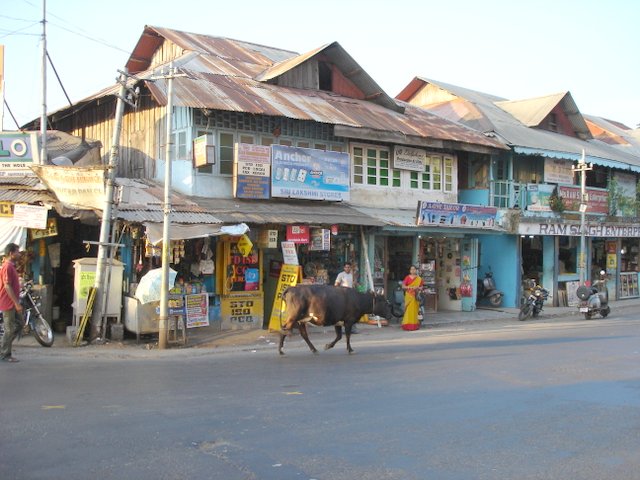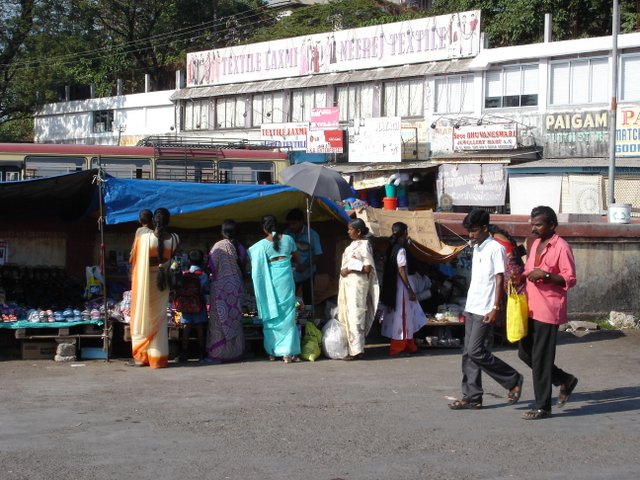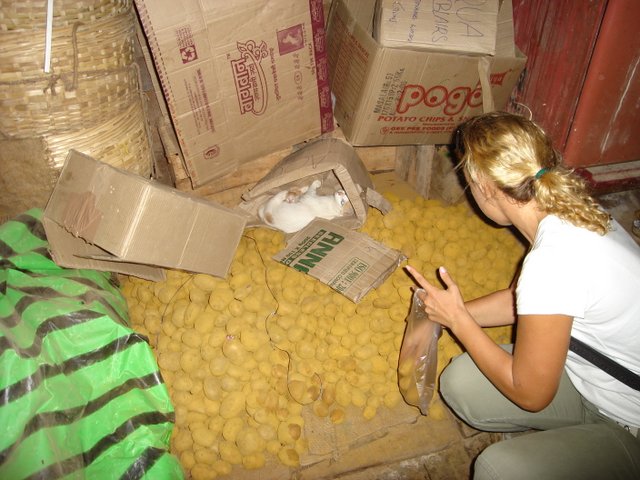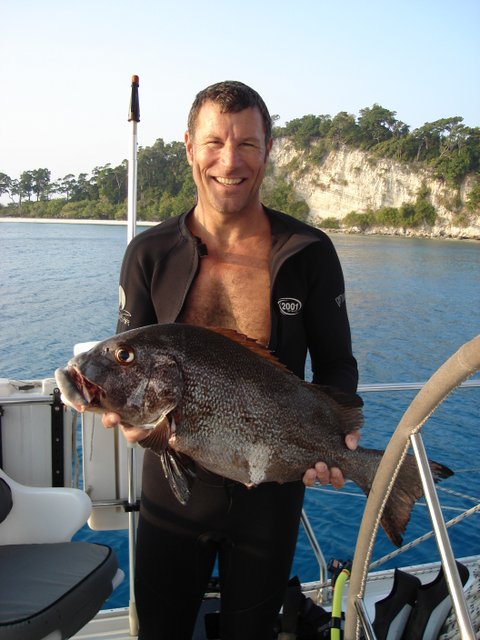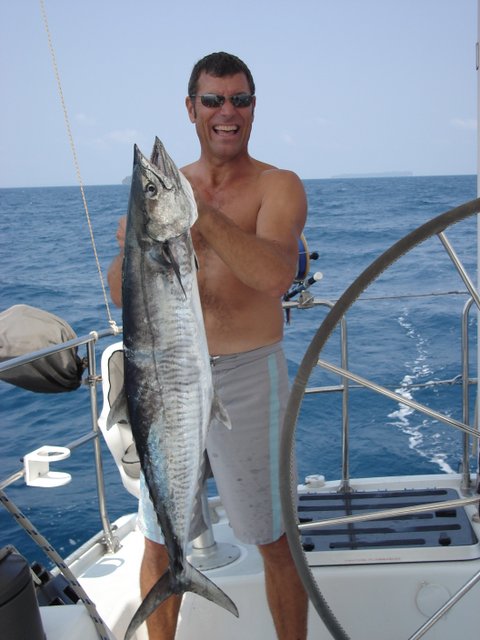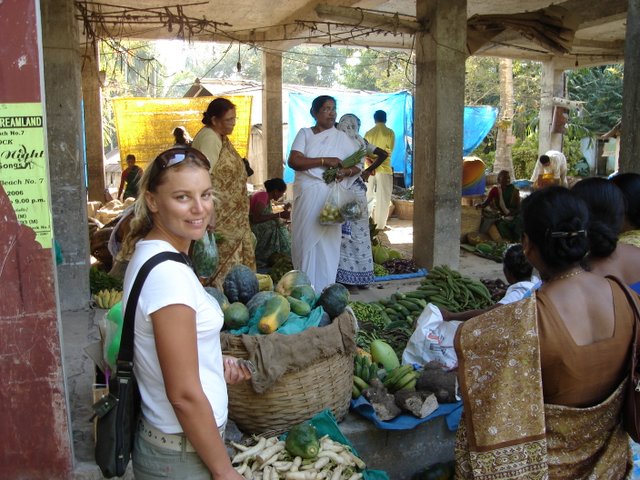On the first leg of our journey across the Indian Ocean, we made landfall at Port Blair in the remote Indian outpost of the Andaman Islands at 0730 on the 17th of January. Port Control granted us permission to enter the harbor and anchor in the area designated for arriving yachts awaiting clearance.
We contacted our agent from Island Travels, who we had previously advised of our arrival date and time and was meant to have all the people organized so that we could complete the check-in formalities within the span of one day. We had a leisurely breakfast on board, cleaned the boat, splashed the dinghy, had lunch, relaxed and were still waiting for the officials to arrive that afternoon.
If the British invented bureaucracy, the Indians have raised it to a fine art. We were warned that the checking in to the Andamans could take up to four days, but with an agent and some advanced preparations on our part, our goal was to cut that in half. Customs and Immigrations finally showed up in the mid afternoon and, of course, they sent four people to do the work of two. We can only wonder what had kept them busy all day in this very quiet port. They handed me a plethora of lengthy forms to fill out, and stated asking a multitude of questions, all at the same time in strong Indian accents, at an almost unintelligible 78 speed. In my frustration, I finally called a “time out” and said that I would be more than happy to deal with each and every one of them to their satisfaction, but please, one at a time! Within an hour, we had ushered them off of Moonshadow, and there was only a subtle hint at some baksheesh, which I treated as if it was a joke. The Coast Guard never did show up that day to perform their “inspection,” but at least we were granted permission to go ashore and partake in some post rally celebrations with the other yachties who had arrived with the rally. We were assured that the Coast Guard would be around “first thing” the next morning, at 0930 hours. Sure!
We took the dinghy to a jetty, where a polite young man offered to look after it for the equivalent to a few bucks. He was very attentive and tied the dink safely to a boat that was anchored well away from the jetty. On shore, the four of us crammed into an “auto rickshaw,” a rather noisy and uncomfortable three-wheeled vehicle that appeared to be a close relative to the ubiquitous Asian tuk-tuk. It is steered with motorcycle handlebars, is powered by a 500 cc two stroke engine, and from what we could tell had just two throttle settings; wide open and closed shut. The advantages over the omni-present black and yellow Ambassador taxis-India’s own version of the boxy old Checker Cab-is that the fares are much cheaper, and they are more adept at darting in and out of traffic, negotiating the narrow backstreets of Port Blair, and dodging the myriad of cows, goats, dogs and potholes strewn about the Andaman Island roads. The auto rickshaw drivers seemingly live hand-to-mouth, because on more than one occasion, they would pull into a gas station and pump just one liter of fuel into the tank, just enough to get us to our destination and the driver back to town.
Before dinner we attended a light and sound show at the Cellular Prison, a harsh detention facility where the British once incarcerated Indian freedom fighters during their occupation of India. It was quite an impressive and entertaining presentation, and gave us a bit of insight into the checkered history of the Andaman Islands. We enjoyed a casual group dinner of Indian food afterwards at the New Light House Restaurant with the other yachties who participated in the rally. The food was quite spicy, but there was plenty of cool Indian beer to put out the fires. After dinner there was an impromptu prize giving ceremony and Moonshadow took second on line and third on handicap in the Andaman Sea Rally.
The next day, the Coast Guard, who were meant to show up at 0930 finally rocked up at 1100 hours. True to form, they sent a boat load of men to do a one or two people’s work. Once again, there were lots of questions, many of which they had the answers to right in their hand, on the copies of the ship’s documentation that I had given to each of them. At least eight times I had to point and say “it’s right there on the form.” The head honcho asked loads of interesting questions, such as if anyone in the crew had ever visited Pakistan and if we were carrying depth charges or underwater mapping equipment. I thought this sort of paranoia was reserved for the United States! We were given instructions on the very strict cruising regulations in the Andamans, including requirements for daily check in with Port Control a.k.a. “Big Brother” indicating our position and intentions, as well as hours to show anchor lights, etc. On a wrinkled old chart he pointed out which islands to avoid as they were supposedly inhabited by cannibals who would attack passers by with arrows and spears, and others where we should avoid swimming because they were infested by salt water crocodiles. Scare tactics? Possibly, but we decided that there was plenty for us to see of the Andamans in the short time we had allotted without risking being skewered or snapped. We were also informed that SCUBA diving required an additional permit that takes two days to obtain. Translating Indian English into American/Kiwi English, we understood that SCUBA diving required us to fill out copious amounts of detailed forms, submitted in quintuplicate, and the permit will take at least 2 weeks to get, maybe longer if there is a holiday or three along the way. We decided to pass.
The final step in this check in process from hell was to meet with the Port Captain, in his office where he would explain the cruising regulations, issue us a cruising permit, and give His approval to our proposed cruising itinerary. I and two other yachties, escorted by our agent, went en masse to finish this last detail. In nearly 13 years of cruising I’ve met scores of Port Captains, none of whom I can say I have any recollection of. The Port Captain of the Andamans is one I will surely NEVER forget. His office was massive, the walls and ceiling stained from years of his cigarette smoke. On one side was his desk and a myriad of side tables and credenzas, all covered in folders full of important looking paperwork. He was most welcoming and amiable and acted like he had the entire day and evening to handle the task now before him.
Before we actually got down to the business of applying for our cruising permit, he told us his life story, showing us photos of the yachts he’d worked on his laptop computer. Then we began to fill out forms for cruising permits as he told us where we could and couldn’t go, where there were man-eating crocodiles and where there were hostile natives. He signed and stamped our permits, and we thought we were on our way. Not even close! He then went into a monologue about how cumbersome the check-in process was in the Andamans. When we politely agreed, we were then requested to send him emails to explain how other countries handle the check-in process so that he could make things more efficient in the Andamans. He explained that he was pushing for a marina to be built for visiting yachts. After the “business” was done, he offered us a swig of vanilla vodka from a plastic water bottle he kept on the credenza behind him. We passed, but he heartily indulged. Then he offered us a smoke. Once again we all passed. Then he asked each of us to tell our life stories. One by one, we told our stories, as briefly as possible. An hour and a half later we finally escaped from his office with cruising permits in hand. Thirty hours after our arrival in the Andamans, we were finally checked in. In most countries we’ve visited in the last few years, the entire process would have taken about 30 MINUTES!
Late that afternoon, we headed into Port Blair to the shopping area called Aberdeen Bazaar, to see a bit of the town and absorb some of the local culture. Port Blair is reminiscent of an old Wild West town with mostly decrepit wood buildings topped with rusty corrugated iron roofs. All that was missing was a “Long Branch” saloon with swinging doors. It gave the appearance that it had been thrown together in a hurry, a long time ago. Bovine creatures have the right of way and wander the streets at will. The rather placid cows are easy to get used to, but the large, noisy bulls with very long, sharp horns can be a bit intimidating to the first time visitor. I wouldn’t advise wearing bright red unless you wish to have a Pamplona experience. Goats also roam the streets freely, rummaging through the trash and competing with dogs for scraps of food. Like anything in this part of the world, after awhile, it all becomes part of the background scenery.
A bull wanders its way through Port Blair.
If the architecture of Port Blair was lacking in style, the women, dressed in beautiful, brightly colored saris certainly looked elegant. Most of the men wore more western style attire but we did see a few men wearing the typical Indian turbans and long cloth wraps around their waist. We enjoyed the hustle and bustle of the town center, the interesting items on offer, people watching, and the ambiance, worlds apart from Thailand which we had left behind just a few days earlier.
Women shopping in their colorful saris.
After a cleansing beer at the New Light House Café, we headed to a local festival, which would be akin to a county fair back in the States. There was lots of loud music and dancing, colored lights, displays by local governmental agencies and booths selling handicrafts, household items and local cuisine. We enjoyed an excellent dinner amongst the local people, but afterwards, the very loud screeching of Hindi music blaring through worn out speakers became a bit too much for our unaccustomed ears, so we headed back to Moonshadow for some peace and quiet. The auto rickshaw driver, thinking we’re stupid tourists, tried to rip us off on the fare. We ended up paying him twice what we paid to get there but less than half of what he was asking. We were reminded to always negotiate a price up front, and if they won’t answer, move on.
The Andaman Islands keep very strict control on cruising yachts. One must get permission before entering the harbor at Port Blair. Permission is required before weighing anchor to depart. A detailed itinerary must be submitted and approved before one can go cruising the outer islands. Some islands are off limits to cruisers or require special permits to visit. Once submitted, a yacht may not vary from its approved itinerary. Yachts must check in with Port Control daily at 0800 with their exact GPS coordinates and intentions for the day. If it is under way, it must give position, heading, speed and destination. Each time a yacht moves, it must contact Port Control when it raises its anchor and then again when it anchors, giving its exact position. We found this sort of Big Brotherism a bit pedantic and took to giving our GPS coordinates down to the thousandths of a minute (less than 2 meters). We heard of other yachts reporting headings of 420 degrees and speeds of 47 knots, while the guy on the other end of the radio attentively noted the information. We sometimes called in four or five times a day to give them our positions, which surely kept them happy, if not entertained. The Andamans see perhaps a few dozen foreign cruising yachts each season, so we’re guessing that we’re a bit of a novelty to these guys who keep close tabs on the normal traffic of freighters and ferries.
Two days in the “big smoke” of Port Blair was enough for us, so early the following morning we started our out-island experience as we sailed south to the Cinque Islands, setting a spinnaker for the first time in more than a year. After a quick douse jibe, we set again and then ZZZZZZZZZZZZZZZZZZ, we’d hooked a fish. The spinnaker was doused so we could reel in the fish. It was a barracuda, which we released. Although barracuda are a good eating fish, they pose a higher risk of carrying ciguatera, particularly when they prey on reef fish. The kite was set again, another fish was hooked up and this time it was an even bigger frikkin’ barracuda, which we again released. We pulled into the anchorage behind North Cinque Island, with its rugged wind-blown landscape and beautiful white sand beach. The anchorage was a bit rolly but it was good to be out in the wilds again!
We found the Cinque Islands to be a bit exposed to the fresh northeasterly breeze and a wrap-around swell, so the following morning we took a leisurely sail west to the bottom of Rutland Island. In its lee the winds were light and seas flat. We sailed around the west side of the island and then turned into Macpherson Strait off the south end of South Andaman Island. Winds were very light and current nearly two knots on the bow. We had plenty of time to take in the beautiful scenery along both of the rugged and undeveloped shorelines as we sailed along at 2 knots over the ground. We anchored near the small fishing village of Chiriyatapu for the evening in a well protected bay just off the beach where the locals congregate regularly to watch the sun set. Graham and Thane took a walk into the village where they were told that the village crocodile farm was wiped out in the Tsunami of 2004 and all the crocs escaped.
We departed Chiriyatapu early the following morning to avoid the winds that built throughout the day, as we were headed north, straight into the prevailing winds and seas. Although the seas were a bit lumpy till we got into the lee of Havelock Island, winds were fairly light, about 6-9 knots. We motor-sailed to the west side of Havelock Island and took anchorage off a long, white sand beach near a backpacker’s resort. We finally broke the barracuda curse and landed a small wahoo, about 5 kg, and polished off one of its tasty fillets for dinner.
The next day was wash day, but after the chores were done, we finished off the remainder of the little wahoo for lunch. In the afternoon, the boys went for a snorkel in a rocky bay just north of where we anchored. The water could have been a bit clearer, but the coral was pristine, and sea life abundant. We saw two schools of huge two-headed parrotfish cruising the reef, many colorful anemones protecting brilliantly marked clownfish, some large stingrays milling about on the sand bottom, a huge potato cod, and a small black lionfish sitting out in the open on the sand bottom near the coral. That evening, the crew of Intrigue, who organized the rally, hosted a huge barbeque party where they had prize giving for their beach golf tournament. There was a lot of good food, wine, music and, of course, plenty of laughs.
We shifted Moonshadow about a half mile north the following morning so that we could be anchored over an excellent snorkeling reef at a spot called Elephant Beach. Spear fishing during the day was unsuccessful as was an evening hunt for lobster, and we didn’t see any elephants playing in the surf. We ended up with pasta for dinner.
After a short snorkel for some photography and spear fishing the next morning, we headed to the north end of Havelock Island where we anchored off a small village with a commercial jetty and ferry terminal. The village had a couple of shops with a few provisions and one slow Internet connection. Tourism was obviously in its infancy stages here. In one little shop, Merima found a few needed provisions including large pile of nice potatoes. Perched on the top of the pile was an old cardboard box that had become a nursery to a cat that had just given birth to a litter of kittens the day before.
We caught an auto rickshaw to a charming resort restaurant called Wild Orchid for lunch. On the return trip, we stopped in the main village at the local fresh market. It was quite a scene as colorful sari-clad women bargained for all sorts of produce items, many of which were unrecognizable to us. The village was very basic, with most of the rickety buildings devoid of paint. On the other hand, the nearby countryside was quite picturesque with lots of banana plantations and pretty rice paddies.
The next morning we made a quick trip ashore get our email at a small shop in the village at Havelock. The lady who owned the place also made ice cream for a few of the resorts on the island so I bought a two-liter tub as a cool treat for the crew. Afterwards, in light north easterlies, we motored north 22 miles to a small speck on the ocean called North Button Island. It isn’t much more than a rocky outcropping with a bit of greenery surrounded by a white sand beach, but nonetheless beautiful and remote. Snorkeling was excellent on the bordering reef. Sea life abounded and we saw many shellfish, eel and two headed parrotfish. Graham and I did a bit of spear fishing and bagged three fish, the largest of which was a 15 pound giant sweetlips. The anchorage became a bit rolly, so we set the flopper stopper and planned to shift to Middle Button Island the next morning, if we were granted permission, of course!
A nice sweetlips.
Middle Button Island is another small outcropping in the Andaman Sea. After a few failed attempts, we finally found a small sweet spot in which to anchor comfortably for a night. Moonshadow was surrounded by a number of coral bommies teeming with sea life, so there was some pretty good snorkeling right off the transom. We did a bit of hunting and saw some nice grouper and sweetlips, but couldn’t get any good shots. I did manage to capture a very strange creature called a mantis shrimp which was hanging out on the sand bottom. It is so named as it resembles the praying mantis insect, and has a set of wicket sharp claws on its front feet. “Shrimp” was probably not the best name for this critter, as it was nearly a foot long when fully extended, and the tail meat tasted a lot like lobster. I’d had a couple of these at a seafood restaurant in Langkawi, and knew they were very tasty.
We all had a good long snorkel on the reef at Middle Button after breakfast the next morning. The water clarity was pretty good and there were plenty of interesting fish and pristine coral to enjoy. We picked up the anchor and had an easy sail with just the genoa towards the Henry Lawrence Island. Our course line took us over a bit of shallow reef where we hoped there would be some big fish lurking. We lucked out and hooked a big one, which took us about 20 minutes to land. It was a beautiful huge wahoo which weighed in at 26 pounds. These fish are pretty good fighters to begin with, but adding to the fight was the fact that we had managed to hook it behind its pectoral fin, so we were pulling it sideways through the water. It felt like we were trying to reel in a sea anchor! We cleaned and filleted it after lunch and the freezer was absolutely chocker.
Wahoo!
We anchored that afternoon in a small, calm bight in the middle of Henry Lawrence Passage, which was bordered by mangrove swamp and native hardwood forest. Before sunset we all hopped into the dink and took a cruise up the river through the mangrove. For an hour we cruised through this gorgeous and apparently untouched mangrove swamp, with not a single sign of civilization-no buildings, boats, cut trees, nor one bit of trash-BEAUTIFUL! After our cruise, we sipped on sundowners while watching a spectacular sunset over the aft deck.
After breakfast the next morning we had a dive in the bight where we were anchored off Henry Lawrence Island. The visibility was not so good but there were lots of fish including some large two-headed parrotfish and lots of anemones with clown fish. After the dive, we headed back to Havelock, relaxed for the afternoon and did a few boat jobs. We went ashore for a dinner out at the Wild Orchid. They served up some excellent food, good wine and the crabs were huge!
The next day we sailed back to Port Blair to begin check out formalities, run a few errands and gather provision for the trip to Maldives. As we entered the harbor, I was reprimanded by Port Control for not obtaining permission to enter the port once again. Jeez, I thought that was just required the first time!
We made our way to town and dropped off laundry at a local service. Laundry in Port Blair is done by hand in large concrete tanks just off the side of a main road, and hung up on nearby lines for all to see as they drive by at full speed, kicking up dust. The next stop was the “supermarket” which was a bit of an overstatement. In the First World, it wouldn’t pass for a small town service station convenience mart. We did find a few basics, but only after combing the entire town’s shops on a scavenger hunt.
First thing the next morning we tried to come alongside the commercial wharf to pick up a load of diesel we had ordered. Port Control gave us permission to go to our choice of three places, two of which were fully exposed to an evil surge, and the third which had concrete pilings sticking up to within a couple of feet of the surface of the water. If I wanted fuel, I had the choice of smashing the topsides or poking holes in the bottom. I told them that none of these places were acceptable and requested permission to come along side a calm bit of wharf on the lee of a peninsula, with about ½ mile of vacant space, for just a half an hour. Port Control would not grant permission saying they had a passenger ship arriving there shortly. It surely would have been the largest ship in the world if it needed all that space! I contacted the agent and asked him to find us a more suitable place to take on fuel. He said that only Port Control had the authority to designate a spot for us and that we had to get their permission. After an hour of going back and forth, I gave up on dealing with all this bureaucratic bullshit and made a decision to sail for the Maldives with our fuel tanks 2/3 full. The trade winds enroute looked to be steady and fresh from the northeast, and from the forecast it looked like these favorable conditions might just hold for our passage.
We popped into Port Blair to top up on dingy fuel and grab some fresh provisions for the passage. The vegetable market, run mostly by Indians, left no doubt in anyone’s mind that we were in the backwaters of India. Between the decaying food and the foul odors, sometimes it was difficult to determine where the market ended and the adjacent sewer began. In all my travels, I’ve never seen a market that was this rough. If I wasn’t looking up to avoid slicing my head open on a low hung piece of rusty corrugated iron roofing, I was looking down to avoid slipping on some decaying vegetables or stepping on a rat. If only Merima knew what she had missed out on! That said, with a bit of effort, I was able paw through some very marginal looking produce to find most of the items we needed at very reasonable prices.
Merima provisioning at the local market.
Across the street, the fresh fruit market, run by Muslims, was its antithesis. It was neat as a pin, and all the stalls had a small assortment beautiful fruits on offer, perfectly stacked and well presented. On the way back to the boat we saw our laundry hanging out along side the road, drying and collecting dust!
That evening, we managed to get back all our laundry, somewhat cleaner than it was when we dropped it off, and enjoy a nice Indian meal at a local restaurant in town. The following morning, permission was granted, and we departed Port Blair and set sail for Male in the Maldives Islands, about 1200 miles to the southwest.

